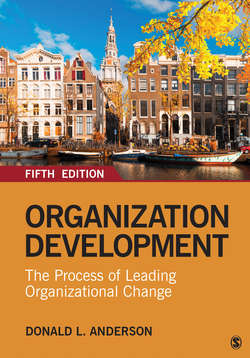Читать книгу Organization Development - Donald L. Anderson - Страница 25
Overview of the Book
ОглавлениеThis book provides an overview of the content of organization development, including theories and models used by change agents and OD practitioners. It also explores the process by which OD is practiced. The objective of the book is to acquaint you with the field of OD and the process of organization development consulting. The goal is to develop your analytic, consulting, and practitioner skills so that you can apply the concepts of OD to real situations. We will simulate these consulting situations through detailed case studies, which follow many of the skill development chapters, in which you will be able to immediately practice what you have learned in the chapter.
Chapters 2 through 5 will explore the foundations of the field, including its history, values, and an overview of the key concepts and research in organizational change. In these chapters you will learn how OD began as a field, how it has evolved over the past decades, and how most practitioners think of the field today. In Chapter 3 we will discuss the underlying values and ethical beliefs that influence choices that practitioners must make in working with clients. Chapter 4 provides a foundation in research into organizational change from a systems perspective, a common way of thinking about organizations. We will also discuss a social construction perspective on organizational change. In this chapter you will be exposed to models of organizational systems and organizational change that have influenced the development of many OD interventions. In Chapter 5 we will define the role of the OD consultant, differentiating the OD consultant from other kinds of consultants, and describing the specific advantages and disadvantages to the OD consultant when the consultant is internal or external to the organization.
Beginning with Chapter 6, the book follows an action research and consulting model (entry, contracting, data gathering, data analysis/diagnosis, feedback, interventions, and evaluation). We will discuss the major actions that practitioners take in each of these stages and describe the potential pitfalls to the internal and external consultant. Chapter 6 describes the early stages of the consulting engagement, including entry and contracting. You will learn how a consultant contracts with a client and explores what problems the client is experiencing, how those problems are being managed, and how problems can be (re)defined for a client. In Chapter 7 we will cover how practitioners gather data, as well as assess the advantages and disadvantages of various methods for gathering data about the organization. Chapter 8 describes what OD practitioners do with the data they have gathered by exploring the dynamics of the feedback and joint diagnosis processes. This stage of the consulting process is especially important as it constitutes the point at which the client and consultant define what interventions will best address the problems that have been described.
Chapter 9 begins by describing the most visible aspect of an OD engagement—the intervention. We will discuss the components of interventions and describe the decisions that practitioners must make in grappling with how to structure them for maximum effectiveness. Chapters 10 through 13 address the traditional OD practices with which most practitioners ought to be familiar, including interventions such as organization design, strategic planning, quality interventions, team building, survey feedback, individual instruments, and coaching and mentoring. These chapters also incorporate practices such as appreciative inquiry, future search, and Six Sigma. These interventions are organized according to the target of the intervention, whether it be the whole organization, multiple groups, single groups, or individuals. In Chapter 14 we will conclude our discussion of the OD process by exploring how organization development practitioners separate themselves from client engagements and evaluate the results of their efforts. In Chapter 15 we will examine the practice of OD in different cultures and geographies by discussing how globalization impacts organization development. The book concludes in Chapter 16 with a discussion of the future of OD, where we will discuss the applicability and relevance of OD to contemporary organizations, given trends in demographics, working conditions, and organizational environments.
Following trends in the corporate world, ethical issues in OD are gaining the attention of academics, clients, and practitioners. While we will discuss values and ethics in Chapter 3, rather than leave ethical dilemmas to that chapter alone, we will also discuss ethical issues in organization development at relevant points throughout the book, when appropriate for the stage in the OD process being described.
Many chapters begin with an opening vignette and thought questions to set the stage for the topics covered in those chapters. Some of these vignettes present published case studies of successful and unsuccessful OD efforts. As you read the vignette and the chapter, consider what factors made the case more or less successful and what lessons the practitioner may have learned from the experience. You may wish to find the published case and read it for additional details not presented in the vignette. Reading published cases can help you develop a deeper appreciation for the complexities of OD work and learn from the successes and struggles that others have experienced. At the end of each chapter you will find questions for discussion, exercises, activities, and/or role-play simulations that can help you develop your OD skills through realistic scenarios where you can practice in a safe environment.
